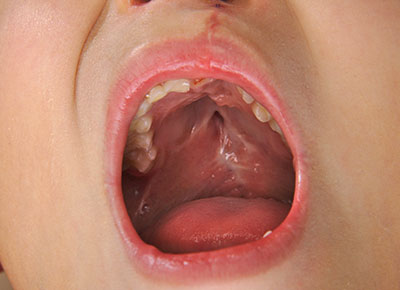Affecting about 1 in every 700 children, cleft lip and palate is one of the most common birth defects today. Luckily, that also makes it one of the most common issues we address here in our office. The treatment for orofacial clefts can be complicated, but modern medicine has the tools to help children born with clefts grow up to live normal, happy lives.
The Anatomy of a Cleft

Clefts occur in one of three areas: the lip, hard palate or soft palate. The hard palate is the bony front of the roof of the mouth by the teeth. The soft palate is the soft, muscular area in the back by the throat.
When a child is gestating in the womb, different parts of the body form at different times. The lip usually fuses completely within just 35 days of gestation. The hard and soft palates take eight to nine weeks. Cleft lip and palate are caused by the lip, soft palate or hard palate not fusing completely during gestation.
Orofacial clefts can take a number of forms. It can be in the center or off to one side. Sometimes, a cleft occurs on both sides. A child can have just a cleft lip, just a cleft palate or both. Some are so small they’re barely noticeable, but others can be quite severe.
Causes and Diagnosis
No one is positive what causes orofacial clefts, but there are a number of contributing factors. Genetics may play the biggest role. The mother’s health, nutrition, environment and medications are the next biggest players. Mothers with diabetes, for instance, or more likely to have a child with an orofacial cleft. Boys are more likely to be born with cleft lips with or without a cleft palate, while girls are more likely to be born with cleft palates but no accompanying cleft lip.
Sometimes, orofacial clefts can be diagnosed while the child is still in the womb. Cleft lips can be visible on routine ultrasounds. Newborns are also screened at birth, with the examiner both looking and gently palpating to see if they can feel the cleft. Other clefts are harder to spot and aren’t caught until the child is older.
About a third of orofacial clefts are associated with other deformities, such as club foot or cardiac defects. If your child is diagnosed with a cleft, your doctor might recommend screenings for other issues.
Common Complications
Orofacial clefts aren’t just a visual defect. They can cause a number of issues both immediately and later in life.
- Feeding: It can be difficult for babies with a cleft lip and palate to form a seal and nurse from their mother or a bottle. Tailored feeding systems, including removable, artificial palates and specialized bottle nipples, are often necessarily to allow feeding and prevent choking.
- Ear Infections: Due to pressure issues, cleft palates are a risk factor for chronic ear infections. The chronic infections can eventually lead to hearing loss. Your doctor might recommend pressure equalization tubes be inserted into your child’s ears to address the problem.
- Dental Problems: As you might expect, missing, malformed and misaligned teeth are common in the area around clefts. Orthodontic work and dental surgery may be necessary later in your child’s life to correct and fill out a full, functional smile.
- Speech Problems: Even if a cleft is corrected early on, your child may develop speech difficulties. Nasal, hoarse or breathy tones are common but correctable with speech therapy and additional, corrective surgeries.
Correcting the Issues
Cleft lips are treated when your child is about 3 months old. The simple procedure brings the sides of the lip together. Cleft palate treatment begins at 6 to 12 months with the first structural treatments. When your child is around 8, a bone graft may be done to help shore up the palate. Other adjustments and corrections may be done over time to help with issues talking, healing and eating. The process might not be complete until your child is in their late teens.
In addition to your ENT team, specialists like plastic surgeons, orthodontists, hearing specialists, and speech therapists and more may be involved in the process.
Your First Appointment
As you get ready for your first appointment with us, it can be be very helpful for our team if you take notes on your child’s symptoms, what makes them worse and what makes them better. You may also want to jot a list of your questions and concerns.
At the appointment, we’ll evaluate your child’s situation, discuss any immediate changes you can make to improve comfort and possibly review treatment options. Early treatment facilitates the reconstruction process and helps minimizes the social difficulties your child experiences due to their birth defect. Call us today to schedule your child’s appointment.

